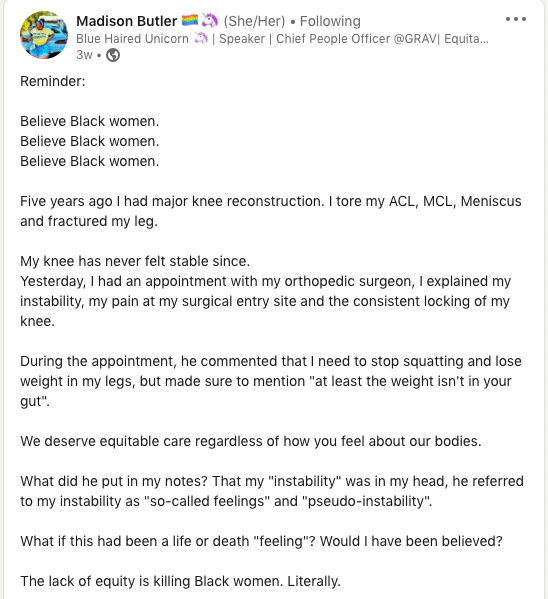Over the past few years, racial and social unrest have prompted company leaders to examine the inequities that exist within their organizations, and explore how we can create safer, more supportive work environments for all employees. From offering remote work options to providing salary transparency to reviewing recruiting practices for potential bias, companies large and small are making great strides to improve their diversity, equity, and inclusion (DEI) strategies.
But one important (and often overlooked) piece of the DEI puzzle? Health equity. Unfortunately, discrimination has plagued our healthcare system for centuries, and employers haven’t done enough to combat those biases and improve access to healthcare.
That’s why today’s leading DEI experts are especially focused on how to promote health equity at both the macro and micro level. We turned to a few leading voices to find out how employers can improve health outcomes, offer a wider range of resources, and create a culture that supports all employees when they’re seeking care.
Here’s what they had to say.
Make healthcare more accessible to more employees with ALEX Go.
What is health equity?
Before we jump into how to achieve health equity within your organization, let’s agree on a common definition of the term.
The Robert Wood Johnson Foundation says health equity means increasing opportunities for all of our employees to live their healthiest lives, no matter who they are, where they live, or how much money they make. And SHRM adds that it’s our responsibility to make that vision a reality:
“Part of employers’ responsibility in creating health equity is guaranteeing that all employees have equal access to health care and that health care plans go beyond taking care of basic needs.”
Of course, employers have offered health insurance as a benefit for years. But now, as racism, sexism, homophobia, ableism and more have taken the national spotlight, we’ve turned our focus to eliminating inequities in the healthcare system. As a result, many employers are asking how else they can provide equal access to the healthcare and other benefits their employees need.
Why is access to healthcare important?
It goes without saying that you want your employees to be happy and healthy. But ensuring that your healthcare offerings are equitable, culturally competent, and meet the needs of all of your employees is especially important right now. And let’s be honest, it’s also a tall order!
But it’s a challenge you need to meet head on. Research shows that in many instances, minorities have less access to healthcare and are less likely to get the care they need from their employer. For example, McKinsey found that Black, Hispanic and Latino, Asian, and LGBTQ+ individuals were less likely to report receiving the care they needed, and were more likely to consider switching employers for benefits-related reasons.
So as you continue to compete for top talent and make your workplace safer for a more diverse range of employees, focusing on equal healthcare access is an important piece of the puzzle.
How to promote health equity at your organization
1. Make your benefits package as diverse as your workforce
It’s no longer enough to offer a healthcare plan, dental and vision insurance, and a retirement account and call it a day. “Health” means a lot more than it used to, encompassing a holistic range of physical, mental, and financial needs.
And as your workforce becomes more diverse, so will their expectations of you as an employer. An inclusive benefits package sets your organization apart, communicating that you understand and cater to your employees’ unique needs—from support for new parents to gender transition assistance to home office subsidies and more.
This is exactly what Natalie Johnson and her team at Paradigm help their clients do. Using their DEI strategy platform, Blueprint, they conduct organizational audits to understand their clients’ benefits offerings, including how they’re deployed and utilized.
Understanding what benefits are available helps Natalie and her team identify potential gaps and areas of opportunity where employers can improve their offerings to appeal to a more diverse workforce.

Not sure where to start? Here’s a list of benefits to consider when you’re thinking about making your offerings more inclusive.
2. Ensure benefits are easy to access, understand, and use
When McKinsey conducted interviews with HR teams recently, one sentiment was clear: there’s room for improvement when it comes to making our benefits packages easy to access, understand, and use.
For example, many HR teams recognize that emails about benefits often go unread, employees may not have time to attend informational sessions during work hours, or have access to internal systems outside of work hours, and spouses may not have access to these systems at all.
McKinsey’s research also shows that people of color and LGBTQ+ employee populations are more likely than their counterparts to find benefits resources unhelpful, no matter their income level.
So providing unbiased, accessible, plainly-worded benefits education can go a long way in helping employees get the care they need. Here are a few boxes to check in order to make that happen:
- Conduct focus groups and surveys with different employee demographics to explore where there might be gaps in understanding.
- Host office hours for employees to access one-on-one, confidential support from a benefits pro (that’s you!) And promote the fact that they’re confidential.
- Review your benefits communication calendar to make sure you’re sending employees important healthcare tips and reminders throughout the year—not just at open enrollment.
- Invest in technology that provides personalized, inclusive benefits guidance depending on each employee’s unique situation.
3. Believe your employees when they say they need care
There’s a long history of discrimination and inequity in the healthcare system that continues to play out today. At its most benign, it prevents marginalized groups from getting the care they need. At its worst, it actively harms and even kills patients.
And while no one employer can individually solve institutional discrimination as a whole, there’s a lot we can do to help our workforces navigate the American healthcare system. It starts with believing our employees when they say they need our help. Take this story from DEI leader, Madison Butler:

No, there’s not much Madison’s employer could have done to change her doctor’s misstep. But it’s a powerful example of how we respond when someone tells us they’re in pain, or need more support, or are asking for our help. How do we apply this story to company culture?
This is the definition of health equity in practice, not just in theory: giving each employee the resources and space they need to stay healthy, at the exact moment when they need it. Because of the stigma attached to asking for help or taking a break, it’s often hard for employees to come to you with requests like these. They’re not taking advantage of your company, they’re knowing themselves. So when they ask, it’s on us to believe them.
Which brings us to our next tip…
4. Destigmatize seeking and receiving care
Recent research shows that we still have a long way to go when it comes to having open and honest conversations about seeking and receiving care, especially when it comes to mental health. In fact, NAMI reports that a large portion of adults with a mental health condition don’t receive care due to stigmas, and that trend disproportionately affects people of color:
What’s worse, employees who do seek care aren’t using the resources you provide them:
There are a few reasons for this. First, employees aren’t aware of or don’t understand the mental health benefits you offer. In fact, we recently found that 76% of HR professionals feel they’re actively increasing access to mental health care, but only 60% of employees agree. Second, healthcare is a delicate topic, and employees may not be comfortable sharing with you:

In fact, 58% of employees would rather use a self-service HR system than speak with an HR specialist. When you don’t know what’s going on with your employees, you can’t guide them towards the right benefits to help them. So how do we destigmatize prioritizing and seeking care?
It starts with leading by example. From your C-suite to middle managers, your company leadership should be as open, honest, and vulnerable as they’re willing to be about seeking care for themselves. They should encourage their direct reports to take mental health days. They should be advocates for your benefits package, regularly reminding their staff to take advantage of the healthcare resources available to them.
It’s also about giving employees an anonymous way to get the guidance they need, without having to talk to someone on your HR team (even if you’re ready and willing to chat!). That brings us to building a foundation of trust with your employees…
5. Develop trust with your employees
We’ve talked about trusting our employees when they say they need healthcare. But how do we make it a two-way street? How do we curate a culture where our employees can trust us with their sensitive health information, so that we can give them the best possible guidance and resources?
Many leading DEI voices agree that that goal is easier said than done.

In other words, your most vulnerable employees likely aren’t willing to share or document their health histories. Why? Because even if you have the best HR team in the world and an open and understanding culture, the employees who need your help the most have been burned one too many times. They might not be comfortable asking for help because they’ve seen too many instances of retaliation, or not enough support given when it was asked for.
That’s where the right technology comes in. When human conversations are too uncomfortable (or challenging), technology can facilitate open, authentic communication, allowing employees to confidentially “talk to someone,” on demand. Tools like ALEX make healthcare conversations feel accessible and easy to understand. This keeps the human relationship at the center while facilitating two-way communication, without the fear of sharing sensitive health information with a coworker. Benefits engagement technology is also personalized to the needs and lifestyle of each person, meeting them where they are.
No, ALEX won’t solve the DEI puzzle. But it is a start — helping you connect with the employees you might not be able to reach otherwise.
It’s not easy to make sure your benefits offerings are equitable to all of your employees. But it’s a challenging job market out there, folks. And the employers who make health equity a priority will be the ones who attract and retain the best talent for years to come. So now is the time to invest in your employees, ensure they have the resources they need, and help them understand how to use them best.
And as always, we’re here to be your partners through it all.


